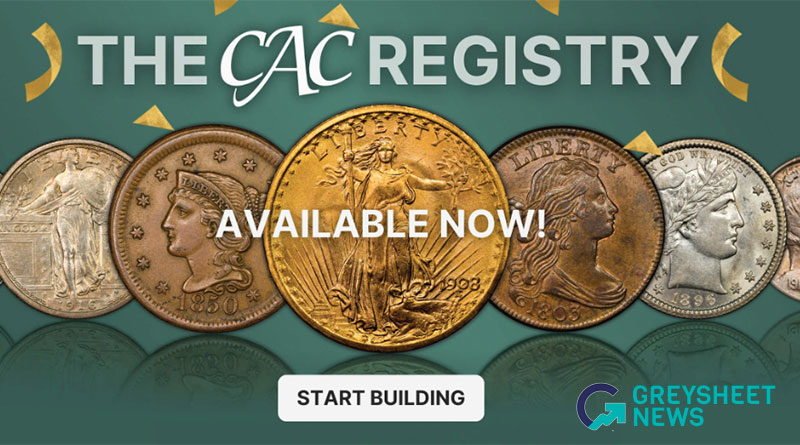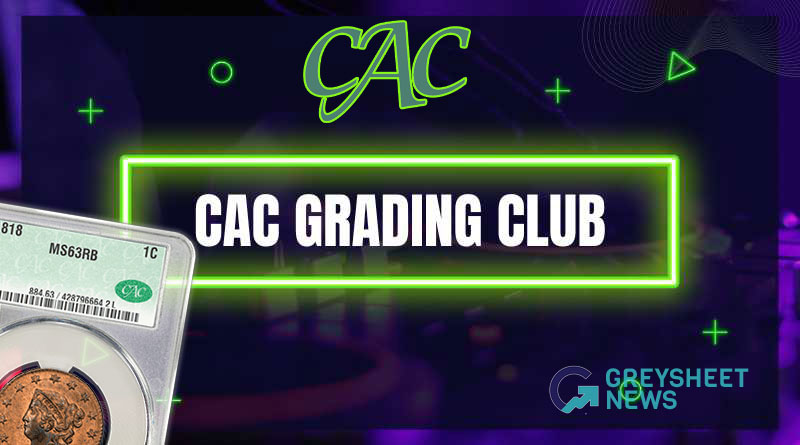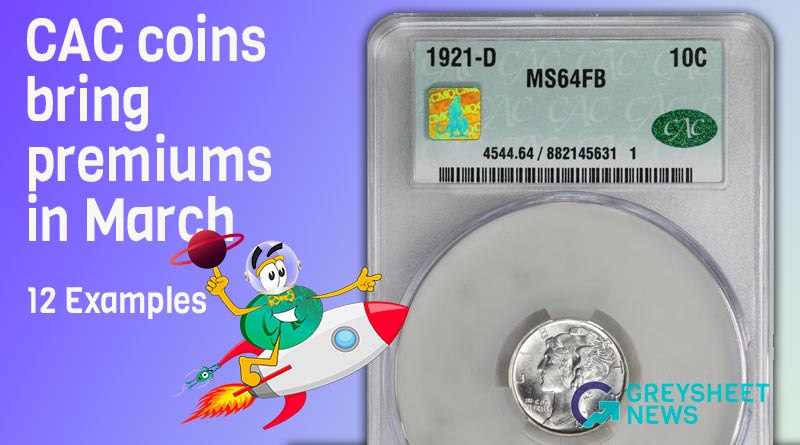CAC Coins Bring Premiums in August
CAC-approved coins outperformed other certified coins in the Heritage Auctions and Stack’s Bowers events at the American Numismatic Association (ANA) World’s Fair of Money show in Philadelphia. Also, CAC coins continued to bring substantial premiums in Internet sales by GreatCollections. Here are 10 examples, which were selected from a large number of results that could have been listed.
- On August 12, GreatCollections sold a CAC-approved MS64 grade 1857 Flying Eagle cent for $1,649. This same firm sold certified MS64 1856 Flying Eagle cents, without CAC stickers, for $1,056 on March 25, 2018, for $1,132 on November 5, 2017, and for $1,031 on August 6, 2017.
- On August 12, GreatCollections sold a CAC-approved MS67 1937-D Buffalo nickel for $703. Recently, this same firm sold non-CAC, certified MS67 1937-D Buffalo nickels that were bid up to levels much lower than $703, $420 on July 22, $405 on July 1, $356 on June 10, and $405 on May 27, 2018.
- On August 14, Heritage auctioned a CAC-approved MS66 grade 1927-D quarter with a ‘Full Head’ designation for $13,200. In January 2017, this same firm auctioned another CAC-approved MS66 “Full Head” 1927-D quarter, which realized $9,693.75. In contrast, in June 2018, Heritage auctioned a certified “Full Head” 1927-D quarter, without a CAC sticker, for $4,320, much less than half as much as the prices realized for either of the cited CAC-approved coins. Also in August 2018, another auction firm sold a non-CAC, certified MS66FH 1927-D quarter for $3,840.
- On August 14, Heritage auctioned a CAC-approved MS66 grade 1915-S $20 gold coin for $9,900. Earlier this year, the same firm sold two certified MS66 grade 1915-S $20 gold coins, each without a CAC sticker, for $5,040 in June and $4,560 in January, respectively. A different auction firm sold a non-CAC, certified MS66 grade 1915-S $20 gold coin for $3,720 in November 2017.
- On August 15, Stack’s Bowers auctioned a CAC-approved, MS64 1886-O silver dollar for $10,800. Two days later, this same firm sold a non-CAC MS64 1886-O silver dollar, which was certified by the same grading service, for $6,600. The results for this duo parallel the sale of two other 1886-O silver dollars that were graded MS64 by the same grading service in the Heritage auction at the Summer FUN Convention in July 2018. A CAC-approved MS64 1886-O then sold for $10,200 and a non-CAC MS64 1886-O then brought $6,021.60.
- On August 15, at the ANA Convention in Philadelphia, Stack’s Bowers auctioned two 1857-O $20 gold coins, in consecutive lots. The first was graded AU50 by the leading service and it sold for $13,200. The second brought $15,600, was graded EF45 by the same grading service, and had a green sticker of approval from CAC. So, the certified EF45 coin, with a CAC sticker, brought more than the certified AU50 1857-O, which was graded by the same service yet did not have a CAC sticker, $15,600 versus $13,200.
- On August 17, at the ANA Convention in Philadelphia, Stack’s Bowers auctioned a CAC-approved, 1917 (Type One) ‘MS-67 Full Head’ Standing Liberty Quarter, for $5,760. All the 1917 quarters mentioned here are of the first type and are certified as MS67 with a “Full Head” designation by the same grading service. Three days earlier at the same convention, on August 14, Heritage auctioned one such quarter without a CAC sticker for $2,040. In April 2018, DLRC sold one with the same certification, also without a CAC sticker, for $2,540. In January 2018, Heritage auctioned another CAC approved 1917 quarter for $13,200! In August 2016, Heritage sold another without a CAC sticker for $2,585.
- On August 17, at the ANA Convention in Philadelphia, Stack’s Bowers auctioned a CAC-approved MS64 grade 1914-S $10 gold coin for $19,800. On April 29, Heritage auctioned a 1914-S $10 gold that was graded MS64 by the same service though was not approved at CAC. This non-CAC coin brought $5,520 in 2018, though a year earlier, that exact same 1914-S $10 coin was sold by Heritage for $7,050.
- On August 17, at the ANA Convention in Philadelphia, Stack’s Bowers auctioned a CAC-approved MS63 1893-CC silver dollar for $7,800. The day before, at the same convention, Heritage auctioned six 1893-CC dollars that were certified as grading MS63. Only one of the six had a CAC sticker and it brought $7,200. Of the five non-CAC, certified MS63 1893-CC dollars that Heritage auctioned on August 16, three realized the exact same price, $5,520. The other two brought $5,640 and $6,600, respectively. On July 18, DLRC sold a CAC-approved MS63 1893-CC for $8000. On July 12, Heritage auctioned a certified MS63 1893-CC, without a CAC sticker, for $6,000. It seems clear that the CAC MS63 1893-CC Morgans have been bringing prices that are significantly higher than those realized by non-CAC MS63 1893-CC Morgans.
- On August 19, GreatCollections sold a CAC-approved, MS65 1923-D $20 gold coin for $2,700. Earlier, GreatCollections sold a non-CAC, certified MS65 1923-D for $1,807 on April 29, and another without a CAC sticker for $1,744 on January 28, 2018.

Download the Greysheet app for access to pricing, news, events and your subscriptions.
Subscribe Now.

Subscribe to Monthly Greysheet for the industry's most respected pricing and to read more articles just like this.
Source: CAC Grading
CAC was formed in 2007 by John Albanese, a respected authority on coin grading and the rare coin market, along with twenty-two leading members of the numismatic community. Because certified coins of the same grade can be of varying quality, CAC’s mission was to advocate for the hobbyist by establishing an extremely stringent standard of grading. As a verifier of previously certified coins, CAC only recognizes coins that meet the highest standard with the now famous green sticker. Out of all the coins submitted to CAC, less than half receive the honorable CAC sticker. As a result, the CAC sticker serves as an unmistakable means of identifying premium coins for the grade.
In 2022, John Albanese assembled over one hundred and fifty leading members of the numismatic community with a purpose to reclaim accuracy and consistency in grading. After all, why merely sticker a previously certified coin when the same stringent standards can be applied within the context of a grading service? Thus, CAC Grading was born! The only difference now is the grade assigned to a coin is a true representation of that coin. Boasting a team of world-class graders including Ron Drzewucki, John Butler, among others, CAC is committed to applying an unparalleled level of expertise to every submitted coin. As a result, hobbyists can have total confidence in a coin certified by CAC.











